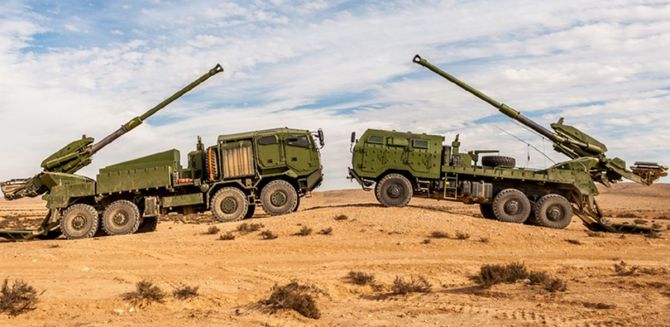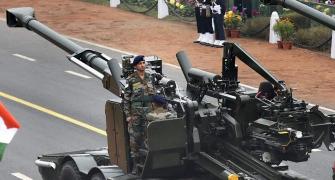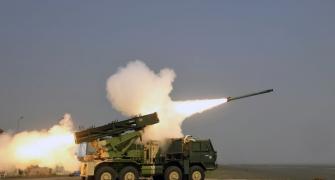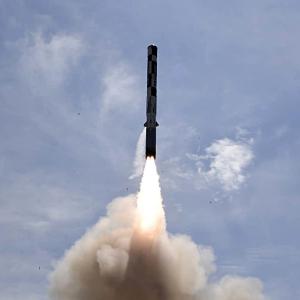'We cannot understand why the government is facilitating the import of artillery when our indigenous guns are doing so well.'
Ajai Shukla reports.

On August 9, the ministry of defence cited the prime minister's Atmanirbhar Bharat (self-reliant India) initiative to ban the import of artillery guns from December 2020.
Twelve days later, the ministry backtracked and allowed imports for an extra year, clearing the decks for importing up to 1,580 guns from an Israeli company, Elbit Systems.
In late 2019, a ministry-constituted Cost Negotiating Committee agreed a price with Elbit Systems for buying 400 towed artillery guns and building another 1,180 in India.
Indian industry executives believe that postponement of the import embargo will see the ministry signing a contract with Elbit.
Indian defence entities that are cooperatively building the Advanced Towed Artillery Gun System (ATAGS), an indigenous alternative to the Israeli gun, had welcomed the August 9 ban on importing 152-millimetre, 52-calibre towed artillery guns from December 2020.
With the ATAGS priced at about Rs 15 crore per gun, an order for 1,580 ATAGS would generate business worth Rs 23,700 crore for the Indian defence production eco-system.
The government's Press Information Bureau Web site carries a defence ministry press statement of August 9, which states: 'MoD has prepared a list of 101 items for which there would be an embargo on the import beyond the timeline indicated against them.'
At Serial 4 in the list of items on which the embargo begins this December is the 155-mm, 52-calibre towed artillery gun.
This embargo, however, is put off for a year by an 'office memorandum' dated August 21, posted on the defence ministry Web site. This document puts a date of December 2021 for the start of the embargo on importing any 155-mm, 52-calibre towed artillery guns.
The chief executive of an Indian defence company says there could be only one possible purpose for postponing the gun import embargo by a year: To import a gun during the extra year granted for imports.
The defence ministry has not responded to a request for comments.
The ATAGS has been designed and developed by the Defence Research and Development Organisation in a public-private partnership with the Kalyani Group and Tata Power (Strategic Engineering Division). The latter is now a part of Tata Advanced Systems Ltd, the Tata group's principal defence company.
"We cannot understand why the government is facilitating the import of artillery when our indigenous guns are doing so well in development," says an official associated with the ATAGS programme.
In successive rounds of testing, the ATAGS has fired shells out to a world record distance of over 48 km. This was achieved using special, long-range ammunition called 'high explosive -- base bleed'.
In comparison, most contemporary 155-mm, 52-calibre guns in service worldwide, including the Israeli Elbit Systems gun, achieve a maximum range of 40-45 km with this ammunition.
The ATAGS also possesses the unique capability of firing five-round bursts, which overwhelms the target with a large quantity of explosive before enemy soldiers can take cover inside their trenches. Other contemporary guns are designed to fire three-round bursts.
The longer range of the ATAGS comes from its larger chamber, which houses a larger quantity of high explosive propellant that shoots out the warhead further.
The ATAGS chamber volume is 25 litres, compared to 23 litres in other 155-mm, 52-calibre towed guns, such as the Israeli Elbit and the French Nexter guns the military has evaluated.
In referring to a 155 mm, 52-calibre gun, the first figure denotes the 'bore' of the gun, or the width of the gun barrel. The calibre relates to barrel length. The higher the calibre, the longer the barrel and the greater the gun's range.
A third parameter is chamber size, which determines the quantity of propellent that can be used and the size of the projectile that the gun fires. A larger projectile causes more damage on the target.
The ATAGS has a major place in the army's Field Artillery Rationalisation Plan, which envisages the acquisition of about 3,000 155-mm, 52-calibre guns.
In addition, the Corps of Artillery is purchasing 155-mm, 39-calibre ultralight howitzers from BAE Systems for use in the mountains.
Meanwhile, Larsen & Toubro is building South Korean K-9 Vajra 155-mm, 52-calibre self-propelled artillery guns for use with tank columns.
Superficially, the ATAGS resembles the infamous Bofors FH-77B, which India bought 410 of in the 1980s before scandal derailed indigenous construction.
In fact, weighing in at 19 tonnes, it is two tonnes heavier than most contemporary towed guns. A key reason for its extra weight is the ATAGS's all-electric drive -- another unique feature of the gun.
The ATAGS has performed well in high altitude trials in January 2018 at the 12,000 foot high Menla Firing Range in Sikkim. However, when the gun went for trials in September, a gun barrel burst while being fired.
This is not an unusual event while developing an artillery gun. I learnt that a multi-agency Failure Investigation Committee had determined that the accident was caused by defective ammunition, and the gun has been found fit to continue trials.
That is likely to be scheduled soon, based on the availability of firing ranges.











